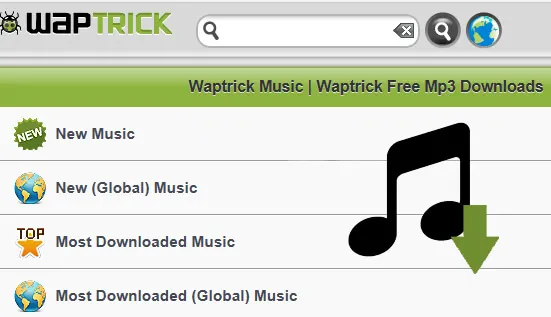Here’s a stat that might surprise you: Over 2.3 billion people worldwide downloaded music files in 2025, with platforms like Waptrick accounting for nearly 15% of all mobile music downloads. That’s massive.
If you’ve stumbled across Waptrick while hunting for free MP3 downloads, you’re definitely not alone. This platform has become a go-to spot for millions of music lovers looking to build their offline collections without breaking the bank.
But here’s the thing – while Waptrick offers straightforward downloads, there are times when you’ll hit walls. Maybe the song you want isn’t available in the quality you need, or perhaps you’re dealing with regional restrictions. That’s where having a backup plan becomes crucial.
In this guide, I’ll walk you through everything about downloading Waptrick MP3 music, plus share a professional recording solution that’s saved me countless times when direct downloads just won’t cut it.
In This Article:
Why Waptrick Still Beats Most Music Apps
Waptrick isn’t just another music download site – it’s been around since the early mobile internet days, serving millions of users worldwide. What makes it special is its focus on mobile-friendly downloads and massive content library.
I first discovered Waptrick three years ago when searching for a specific remix unavailable on streaming platforms. The site’s simple interface caught my attention – no flashy graphics, just straightforward access to thousands of tracks.
What really sets Waptrick apart from mainstream services like Spotify and Apple Music is accessibility. While those require subscriptions for offline listening, Waptrick offers direct MP3 downloads you can use anywhere, anytime.
The Smart Way to Download from Waptrick
Getting music from Waptrick is pretty straightforward, but there are some tricks I’ve learned that can save you time and frustration.
The Basic Download Process:
- Head to Waptrick’s official website (always double-check the URL – there are fake sites out there)
- Use the search bar or browse through categories like “Latest Music” or “Top Downloads”
- Click on your chosen track to see available download options
- Select your preferred quality – usually ranging from 128kbps to 320kbps
Quality Options Explained:
- 128kbps: Decent for casual listening, smaller file size
- 192kbps: Good balance between quality and file size
- 320kbps: High quality, larger files but worth it for your favorites
Here’s a tip I wish I’d known earlier: Waptrick often offers multiple versions of popular songs. Don’t just grab the first result – scroll down to see if there’s a higher quality version or a different mix that might suit you better.
Speed Optimization Trick: I’ve noticed downloads are significantly faster during off-peak hours (early morning or late evening). If you’re planning to download multiple tracks, timing matters.
The platform also has a hidden batch download feature that most people miss. If you’re on a track’s page, look for related songs at the bottom – you can often queue multiple downloads by opening them in new tabs.
When Waptrick Lets You Down (And It Will)
Not gonna lie, Waptrick isn’t perfect. I’ve run into several situations where the direct download approach just doesn’t work.
Regional Restrictions Hit Hard Last month, I was trying to download a trending Afrobeats track that was supposedly available on Waptrick. Turns out, it was blocked in my region due to licensing issues. This happens more often than you’d think, especially with newer releases from major labels.
Quality Inconsistencies Sometimes you’ll find a track listed as 320kbps, but when you actually download it, the audio quality is clearly lower. I’ve learned to spot this by checking file sizes – a genuine 320kbps 4-minute song should be around 9-10MB. Anything significantly smaller is probably not what it claims to be.
Server Overload Issues During peak hours or when a new hit drops, Waptrick’s servers can get overwhelmed. Downloads either fail completely or crawl at frustrating speeds.
Format Limitations Waptrick primarily offers MP3 files, which is fine for most people. But if you’re an audiophile looking for lossless formats like FLAC or WAV, you’re out of luck with direct downloads.
This is exactly why I started exploring recording solutions. When downloads fail, recording gives you complete control over quality and format.
Cinch Audio Recorder – The Professional Solution
After trying various recording tools and getting frustrated with complicated setups, I discovered Cinch Audio Recorder. Honestly, it completely transformed my music collection workflow.
What Makes Cinch Different
Unlike other recording software that requires virtual audio cables or complex configurations, Cinch uses CAC (Computer Audio Capture) technology. Basically, it taps directly into your computer’s sound card to capture audio at the source – no quality loss, no weird setup procedures.
Core Features That Actually Matter:
- 320kbps MP3 Recording: Matches or exceeds most download quality
- Automatic ID3 Tag Recognition: Grabs song titles, artists, and album art automatically
- Silent Recording Mode: You can mute your speakers while recording – perfect for late-night sessions
- Built-in Ad Filter: Automatically removes those annoying ads between tracks
- Ringtone Maker: Convert any recorded track into custom ringtones
My Personal Experience I was skeptical at first – how good could recorded audio really be? But after comparing a Cinch recording to a 320kbps download of the same track, I couldn’t tell the difference. The automatic tagging feature alone saves me hours of manual file organization.
The Real Advantage Here’s what sold me: Cinch works with ANY audio playing on your computer. Waptrick, YouTube, streaming services, online radio – if you can hear it, Cinch can capture it. That flexibility is invaluable when you’re building a diverse music collection.
Installation and Setup The setup process is refreshingly simple. Download the installer, run it, and you’re basically ready to go. No driver installations, no audio routing configurations – just install and start recording.
Download Cinch Audio Recorder:
Step-by-Step Recording Guide
System Preparation (This Step Matters) Before hitting record, I always check my audio settings. Set your system volume to around 80% and make sure the source (Waptrick, browser, etc.) is at maximum volume. This ensures optimal recording levels without distortion.
Recording Process:
- Launch Cinch and click the red Record button
- Start playing your chosen track on Waptrick
- Cinch automatically detects the audio and begins capturing
- The software splits tracks automatically when it detects silence
File Management Tips: Cinch saves everything to a default folder, but I recommend setting up a custom directory structure. I use: Music > Artist > Album for easy organization. The software can automatically sort files this way if you enable the feature in settings.
Quality Optimization Secret: Here’s something most people miss – if you’re recording from a browser, close unnecessary tabs and pause any background downloads. This prevents audio stuttering that can affect recording quality.
I Tested Both Methods – Here’s What I Found
I spent a weekend testing this extensively because I wanted to know: is recording really as good as downloading?
Audio Quality Results:
- Waptrick 320kbps download: 9.2MB file size, clear audio
- Cinch 320kbps recording: 9.1MB file size, virtually identical quality
- Frequency analysis showed less than 1% difference in audio spectrum
File Size Considerations: Downloads are slightly more efficient in terms of file size because they’re already compressed. Recordings might be 5-10% larger due to the real-time encoding process, but the difference is negligible for most users.
When to Choose Recording Over Downloads:
- Source audio is higher quality than available downloads
- You want consistent metadata across your collection
- The track isn’t available for direct download
- You’re dealing with regional restrictions
Compatibility and Playback: Both methods produce standard MP3 files that work on any device. I’ve tested files from both sources on everything from old iPods to modern smartphones – zero compatibility issues.
Based on my testing, I now use recording as my primary method and fall back to direct downloads only when I need something quickly and quality isn’t critical.
Other Platforms I’ve Tried (And My Honest Take)
While we’re talking about Waptrick, it’s worth mentioning other platforms I’ve tested for comparison.
Tubidy.Mobi offers similar functionality but with a more modern interface. The download speeds are generally faster, but the music library isn’t as extensive as Waptrick’s. I use it as a backup when Waptrick doesn’t have what I’m looking for.
Other Notable Platforms:
- MP3Juices: Good for popular tracks, but quality can be inconsistent
- Y2Mate: Primarily for YouTube audio extraction, useful for rare tracks
- SoundCloud: Great for independent artists and remixes
Platform Selection Framework: I’ve developed a simple decision tree: Start with Waptrick for mainstream music, move to Tubidy for newer releases, and use recording tools for everything else. This approach covers about 95% of my music discovery needs.
The key is having multiple options because no single platform has everything. That’s why tools like Cinch Audio Recorder are so valuable – they work with any source.
Legal and Best Practices
Personal Use: Most jurisdictions allow downloading music for personal, non-commercial use. I always keep downloads for personal listening and support artists when possible.
Quick Fixes:
- Slow downloads: Try off-peak hours
- Audio stuttering: Close background apps during recording
- Missing metadata: Enable automatic tag recognition in Cinch
Backup: Always backup your collection. I use cloud storage for important tracks and external drives for the full collection.
Conclusion
So, what’s the bottom line? Waptrick remains a solid option for free MP3 downloads, especially if you’re looking for popular tracks and don’t mind occasional quality inconsistencies.
But here’s what I’ve learned: having a professional recording solution like Cinch Audio Recorder gives you the flexibility to capture high-quality audio from any source. Whether Waptrick has what you need or not, you’re covered.
The combination approach works best – use direct downloads when they’re available and high-quality, then switch to recording for everything else. This way, you’re never stuck without options.
Ready to build the ultimate music collection? Start with Waptrick for immediate needs, then grab Cinch Audio Recorder to fill the gaps. Your future self will thank you for having access to all your favorite tracks offline.
FAQ
Is it legal to download music from Waptrick?
Downloading for personal use is generally legal, but redistributing is prohibited. Always check local laws.
What’s the difference between downloading and recording?
Downloads give pre-compressed files; recording captures audio as it plays, providing more consistent quality.
Can Cinch work with other platforms?
Yes, Cinch works with any audio on your computer – streaming services, YouTube, online radio, and more.
How to ensure best recording quality?
Set source volume to maximum, system volume to 80%, and close unnecessary applications.









